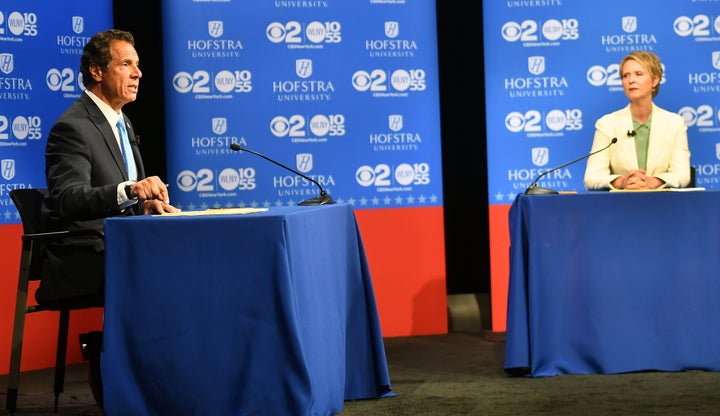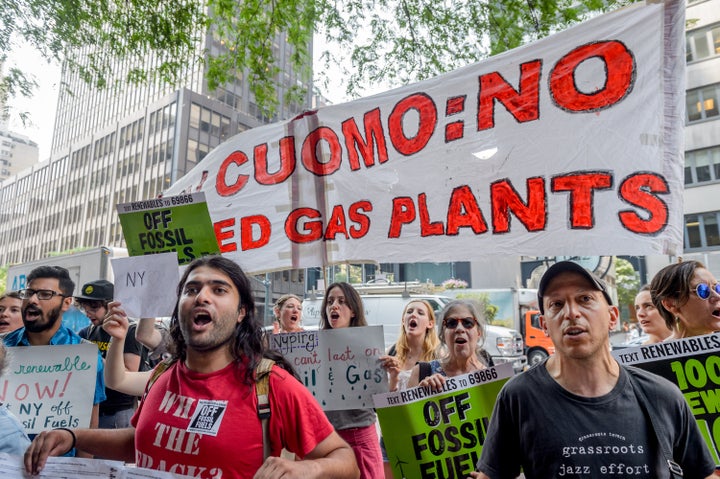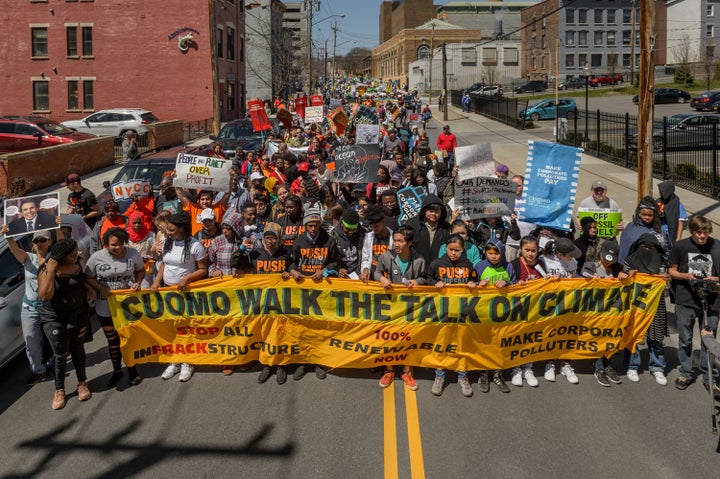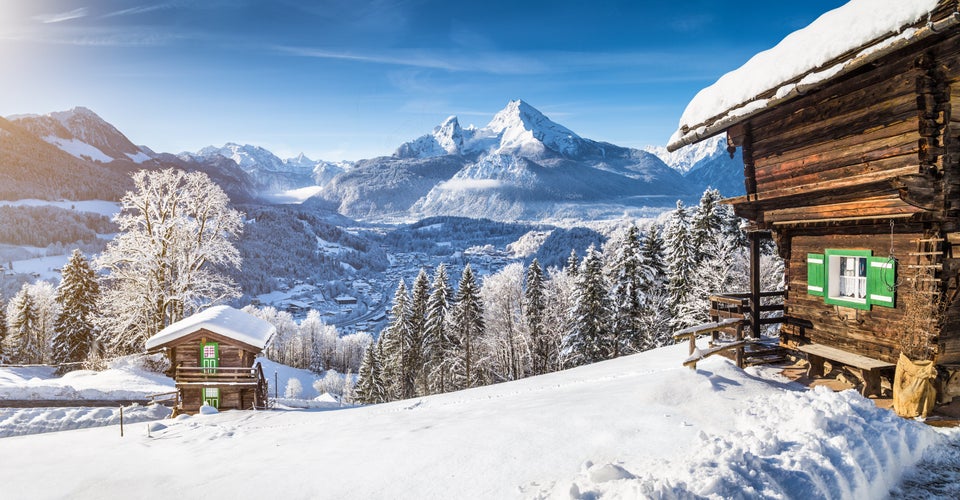
There was a time when New York Gov. Andrew Cuomo (D) fashioned himself as the nation’s most aggressive governor on climate change.
Back in December 2014, Cuomo announced he was banning hydraulic fracturing ― the controversial drilling technique known as fracking ― in New York, a bow to environmentalists who had led months of fierce protests. In October 2015, Al Gore stood by Cuomo’s side as he announced plans to cut the state’s greenhouse gas emissions 40 percent by 2030. A month later, Cuomo vetoed a major gas port off Long Island. In February 2016, Cuomo even called for a last-minute risk assessment report and asked federal regulations to halt construction of the Algonquin gas pipeline, despite his administration granting earlier approvals.
When President Donald Trump announced the United States would withdraw from the Paris climate accords in June 2017, Cuomo formed an alliance with California Gov. Jerry Brown (D) to maintain the emissions cuts pledged as part of the global agreement.
At Wednesday night’s only televised debate before the Sept. 13 gubernatorial primary, Cuomo listed climate change as one of the top three threats he’s charged with defending New Yorkers against.
“Know me by my enemies,” he said.
But heading into the Thursday primary, Cuomo finds himself at war with New York environmentalists. Activists say Cuomo’s climate policies amount to half measures and fig leaves for a conservative Democrat bent on maintaining lucrative ties to donors in the fossil fuel industry and quashing legislation that might jeopardize plans for a centrist run for the White House.
Cuomo also faced an environmental revolt in the 2014 primary, as protesters rallied behind his progressive primary challenger, Zephyr Teachout, who had promised to keep drilling companies out of New York.
This year, many environmental activists are rallying behind Cynthia Nixon, a democratic socialist who staked out plans to fine polluters for climate pollution and use the money to shift New York’s electricity to 100 percent renewables by 2050. But this time, it’s different. Cuomo may have ameliorated environmental concerns by enacting a fracking moratorium last time, but countering Nixon’s vision for the future would require him to radically shift the state’s energy policies and make enemies of one of the nation’s most powerful industries. There’s little indication Cuomo, who did not respond to an interview request for this article, plans to do that.
But Cuomo’s story is one many centrist Democrats are grappling with as fossil fuel emissions hit an all-time high, the president dismisses climate science as a hoax and the GOP is gutting nearly every major federal climate policy: whether to propose bold action or continue to cower behind powerful fossil fuel interests. Even if Democrats retake the House in November, there’s no plan to push for a sweeping climate bill. There’s no consensus on what kind of policy the party supports to reduce greenhouse gas emissions. The Democratic National Committee last month backtracked on its most radical action to date, a pledge enacting a limited ban on corporate donations from fossil fuel companies.
Rising Heat
Cuomo’s environmental troubles started on one of the first hot days last April. More than 1,500 protesters bused into downtown Albany from across the state, rallying at the site of a defunct trash incinerator the state plans to turn into a gas plant. Nixon showed up, telling a throng of reporters that the historically low-income, black neighborhood “has a really terrible racist history of environmental pollution.”
“Fracked gas is not a bridge to a cleaner energy economy,” she said.

The remark was a direct jab at the governor. Two weeks earlier, Cuomo told the Buffalo News “you need natural gas” as a bridge fuel to renewables.
“The conduit for natural gas then becomes the question. And pipelines, in general? Fine,” Cuomo said. “As long as they’re done well and they’re done correctly.”
Chanting “Heyo Cuomo, walk the talk,” the demonstrators filled the streets of the state capital’s downtown in what became the largest climate march in Albany’s history, ending at the capitol itself.
After nearly a decade of Cuomo’s uninterrupted rule, New York gets just 1 percent of its energy from solar and 3 percent from wind.
“We’re extremely disappointed with Cuomo’s sluggish transition to renewable energy,” said Alex Beauchamp, a director at the nonprofit Food & Water Watch. “Despite an almost constant deluge of press releases touting the state’s progress ... Cuomo has been in office eight years and barely moved the needle on renewable energy.”
Part of the problem is the Cuomo administration’s decision last year to scrap net metering, a policy that allows homeowners and businesses with solar panels to sell excess energy produced during the day back to utilities at premium rates. In its place, the state’s Public Service Commission put in place a system called Value of Distributed Energy Resources, or VDER, which assigns a price to excess solar energy based on a litany of variables, including where in the state it’s produced and what time of day the electricity is pumped back onto the grid. The new rule, which is seen as more favorable to utilities, is blamed for hindering nascent community solar projects around the state, earning it the pejorative nickname “Darth VDER.”
“It’s so complex most people don’t even understand it,” said Lee Ziesche, an organizer for the New York advocacy group Sane Energy Project. “A lot of projects are not able to find funding now because it’s really unclear what the prices are going to be that they’ll get for this solar.”
As renewable energy production sputters, the governor has plowed ahead with building new fossil fuel infrastructure. Gas and fuel oil make up more than one-third of New York electricity generating capacity.
He set aside $88 million in the state budget this year for the New York Power Authority to begin construction on the gas plant in Sheridan Hollow, the majority black neighborhood of Albany, ignoring calls from community leaders to explore zero-emissions geothermal technology instead. Cuomo has remained silent on the project for months.
In the Hudson Valley’s Orange County, the nearly $900 million Competitive Power Ventures gas plant is set to go online in the coming weeks despite fierce opposition and a bribery scandal for which Joseph Percoco, one of Cuomo’s top aides, is expected to be sentenced to prison in the coming weeks.
Last month, Cuomo ignored calls from local activists in the Finger Lakes region to scuttle plans to convert one of the state’s oldest coal-fired plants into a gas-fired power station. Opponents say the plant would require convoys of between 50 to 120 trucks to deliver natural gas to the Cayuga Lake plant per day.
There are other plants: Cricket Valley Energy Center in the lower Hudson Valley; further north, the Danskammer Generating Station in the Town of Newburgh; and Caithness II, out on Long Island. The company planning to repower the coal plant in Dunkirk, New York, with natural gas abandoned the proposal in July.
“Zephyr and all the fracktivists getting him to ban fracking here four years ago was really important,” Nixon said during a climate town hall on Thursday night. “But it’s nullified by the fact of how much fracked-gas infrastructure he’s allowed to be built.”
On pipelines, Cuomo’s environmental bona fides are stronger. Two years ago, as the fights over the Dakota Access and Keystone XL pipelines captured national attention, the governor took a novel approach to upending pipeline projects, denying permits with nuanced legal arguments about the impacts of greenhouse gas emissions. The moves drew praise from national green groups.

But that approach hasn’t stopped the Algonquin Incremental Market pipeline, a project to expand the natural gas conduit to run near the Indian Point Energy Center, a controversial nuclear plant in Westchester slated to be shut down. The state recently released a report warning of risks to building a pipeline of combustible gas under a plant storing four decades of irradiated materials, confirming what local activists said for years.
“Gov. Cuomo has done nothing to address those risks,” Courtney Williams, an activist in Peekskill, New York, said during Nixon’s town hall on Thursday. “He did nothing. And now that the state and he has acknowledged those risks, he’s still doing nothing.”
Environmentalists blame Cuomo for accepting donations from fossil fuel companies. His campaign received nearly $113,000 in contributions from the oil and gas industry from January 2015 to mid-January 2018. In May, Cuomo headlined a gala funded by big oil companies.
At issue, too, is Cuomo’s refusal to back legislation to mandate New York shift to 100 percent renewable electricity. The state Assembly has thrice passed the Climate and Communities Protection Act, a widely-hailed bill mandating the state receive all of its electricity from renewables by 2050 and spend 40 percent of its energy funding on low-income communities. But the bill has never come up for a vote in the Senate, where a group of breakaway Democrats caucus with Republicans, giving the GOP a majority. Other bills have met similar fates. Legislation introduced last September to phase out the $1.5 billion New York spends on fossil fuel subsidies each year hasn’t made it to the Senate floor. Democratic activists in the state generally blame Cuomo for the creation of the Independent Democratic Conference, which they say helps the governor quash progressive bills that would cost his donors money or upset his chances of courting Republican voters in a future presidential run.
Nixon made supporting the climate bill, known as the CCPA, the central tenet of her climate platform. Some activists criticized the move, saying the 2050 goal is too late and pointing to candidates like Alexandria Ocasio-Cortez ― the likely next U.S. representative for New York’s 14th Congressional District ― who are running on the national target of 100 percent renewable energy by 2035. But Nixon also vowed to support a long-awaited sister bill that would levy a fine on polluters, revenues from which would be used to fund the grand-scale renewable buildup mandated by the CCPA. Nixon eschewed all corporate donations and has hit Cuomo particularly hard on his fossil fuel donations.
On other issues, activists blame Cuomo for being slow to act. Over the past three years, New York has struggled with a series of high-profile water contaminations from toxic perfluorinated chemicals, cancer-causing compounds used in non-stick Teflon and firefighting foam. In one case, a town in upstate New York was left drinking water well above the recommended limit for months before the state stepped in, and only as Michigan Gov. Rick Snyder (R) was facing national scrutiny for failing to act swiftly on the Flint lead crisis. In another case, one of the state’s poorest cities sued the Cuomo administration for failing to clean up the contamination at the source.
Judith Enck, who served as New York’s regional EPA administrator for eight years under President Barack Obama, criticized Cuomo for failing to establish a strict new limit on how much perfluorinated chemicals can be in water before the state takes action. Even as states like New Jersey and Vermont enact such limits, the committee Cuomo created to study the policy remains tied up in bureaucratic meetings.
“You need to work the process with Gov. Cuomo, but we found that he has been responsive.”
- Paul Gallay, Riverkeeper
“Over two years ago Governor Cuomo said New York would do the same but instead of doing that, the governor named yet another advisory committee,” Enck said in an email. “Clearly, Governor Cuomo does not have a sense of urgency in addressing these drinking water issues.”
Identifying this as a vulnerability for Cuomo, Nixon launched her campaign with a video that featured the City of Newburgh, the impoverished municipality that sued the state over its contamination. She also made a trip to Hoosick Falls, the first town where a chemical contamination was discovered, days after declaring her candidacy.
Still, Cuomo has his defenders. Paul Gallay, president of the New York nonprofit Riverkeeper, praised the governor for setting aside more than $3 billion over the past three years to rebuild drinking water and sewer infrastructure. He said Cuomo’s decisions to phase out Indian Point and ban fracking made for “a pretty good one-two punch.”
“You need to work the process with Gov. Cuomo, but we found that he has been responsive,” Gallay said by phone. “There are a number of areas where, given the right data and right community engagement and right community advocacy, the administration has fostered greener policies.”
Vote Like Your Whole World Depended On It
Despite their policy differences, Cuomo avoided mainstream criticism of his environmental agenda during Wednesday’s debate. The CBS moderators did not ask about climate change or tainted water. Cuomo mentioned climate early on, prompting Nixon to call him out at the debate: “Why, when we have pulled out of the Paris climate accord, why have you not fought for the Climate & Community Protection Act?”
Nixon’s candidacy has emboldened environmental groups.
In June, Cuomo told a teenage activist at a fundraiser he would swear off fossil fuel money, then walked back the statement a day later. In July, protesters demanding the governor support legislation to move the state to 100 percent renewable energy paddled kayaks to singer Billy Joel’s Long Island mansion, where Cuomo was holding a fundraiser. In August, environmentalists staged a sit-in at the governor’s Manhattan office until eight were arrested. Later that month, they launched the campaign website CuomoWalkTheTalk.org, outlining their grievances.
On Sept. 6, a broad coalition of environmental groups is planning a march through Manhattan.
“Cuomo has so many corporate donors and takes so much money from the fossil fuel industry that we forget we don’t have to push and shove and get arrested to get Democrats to listen to us,” said Matthew Miles Goodrich, political director of the nonprofit Sunrise Movement’s New York, who was arrested last month at Cuomo’s Manhattan office. “Cynthia shows that another world is possible if we can elect better Democrats.”

